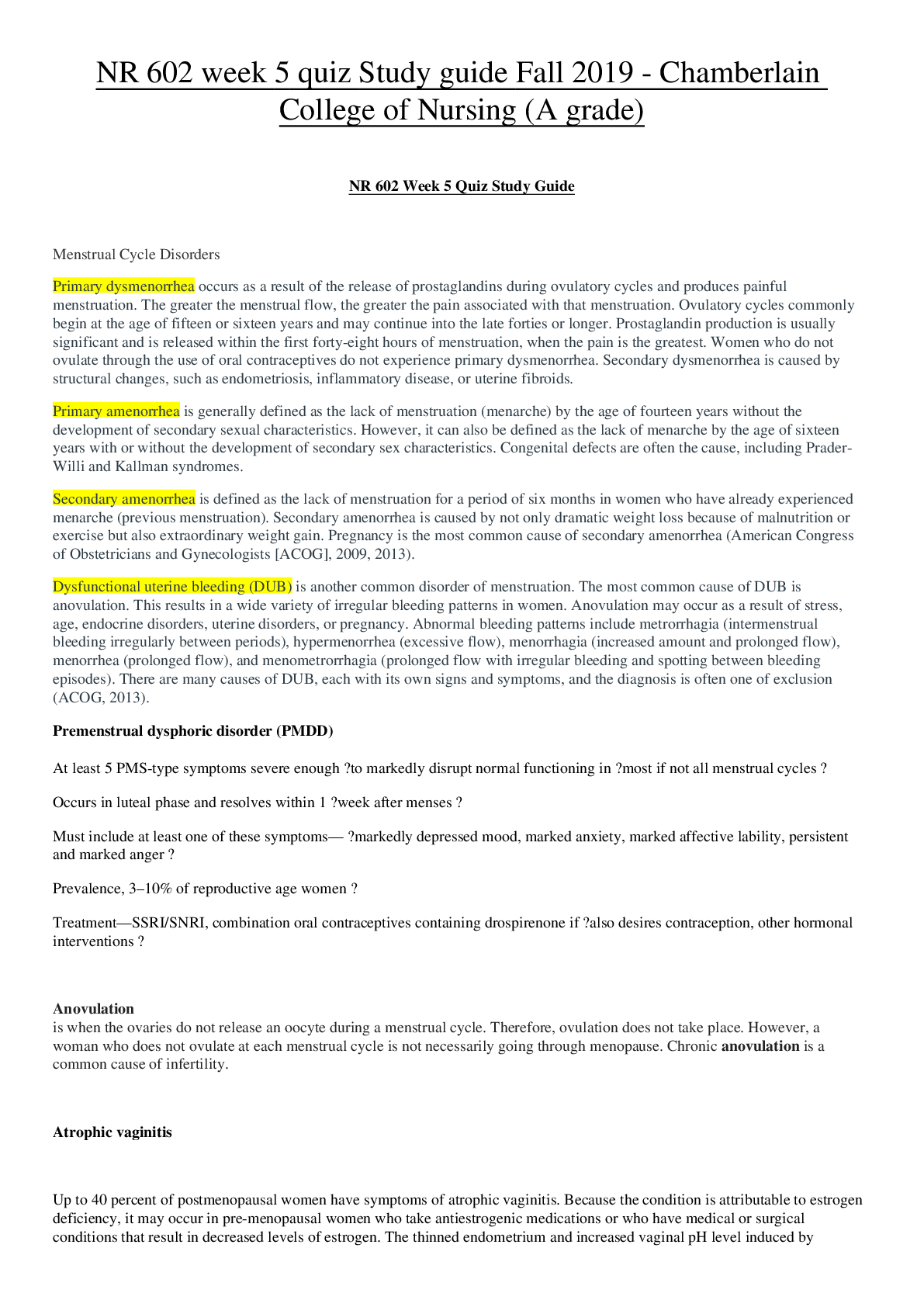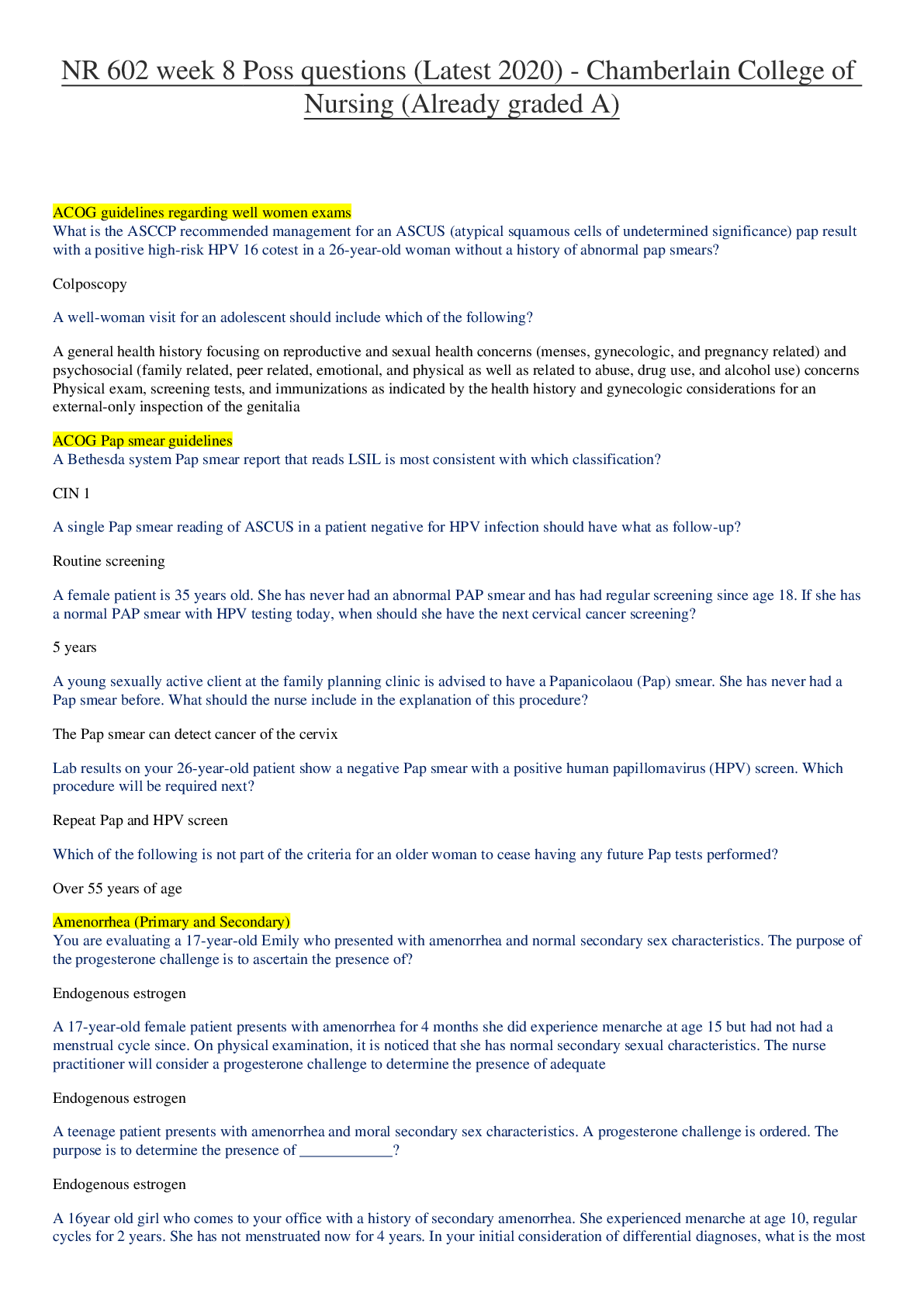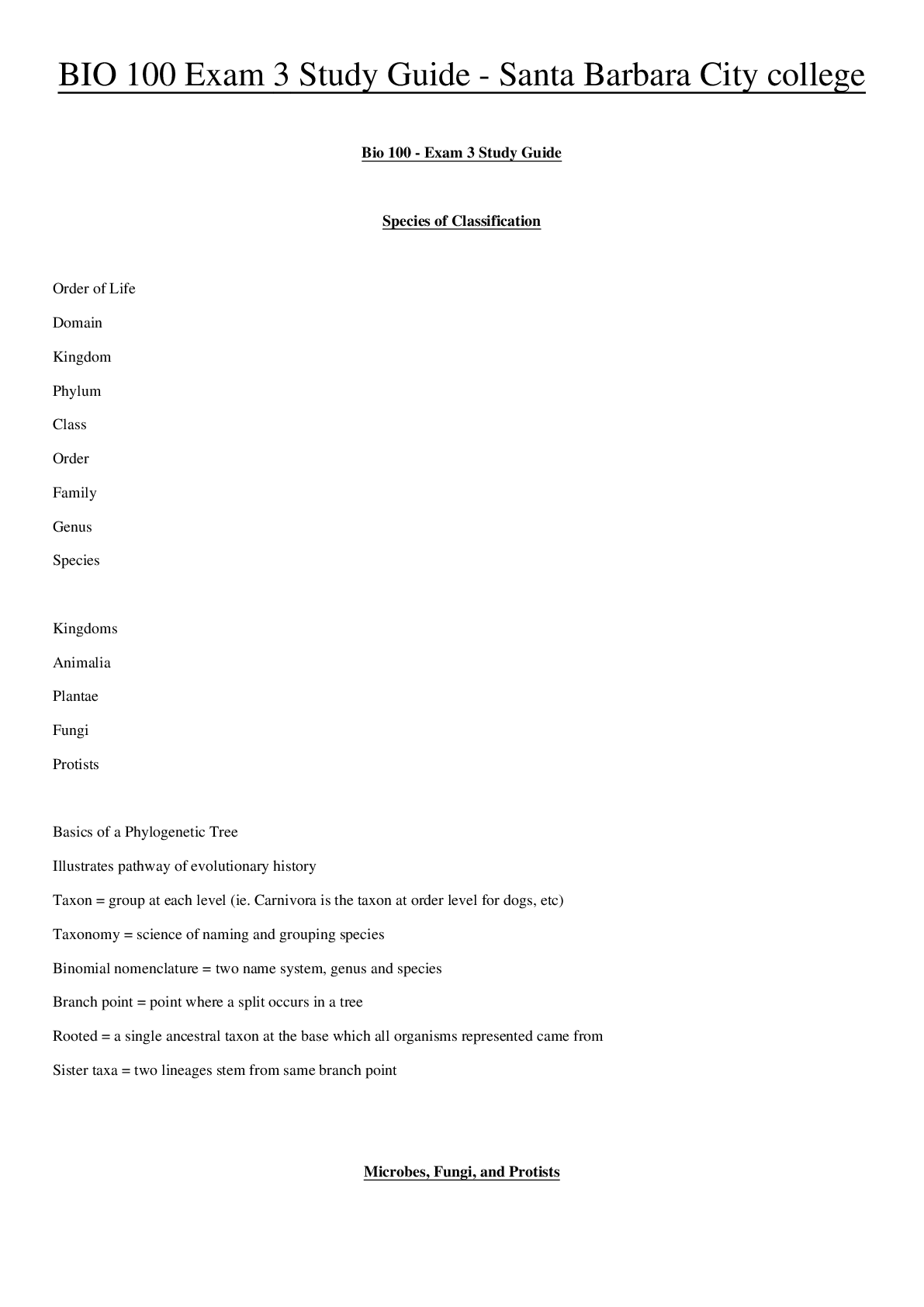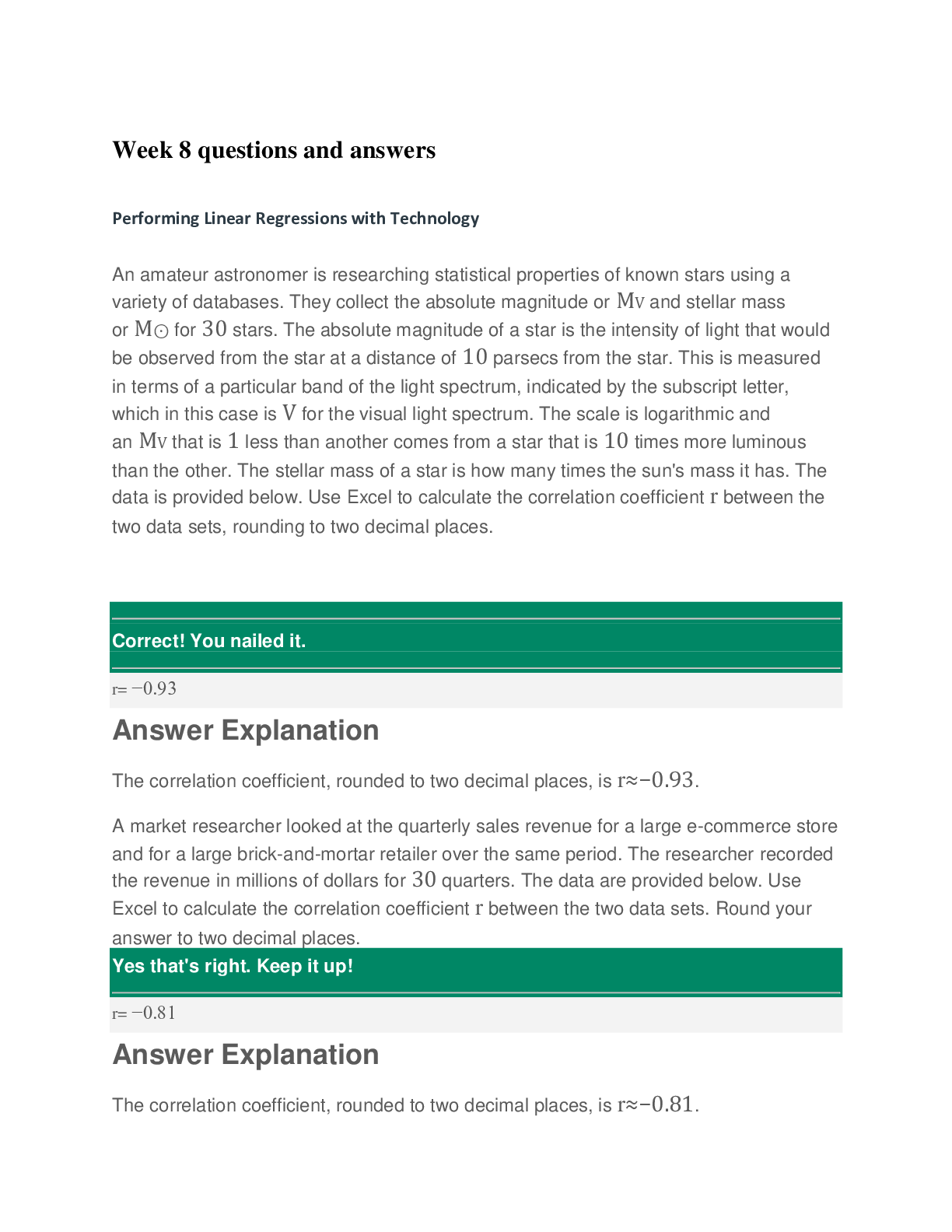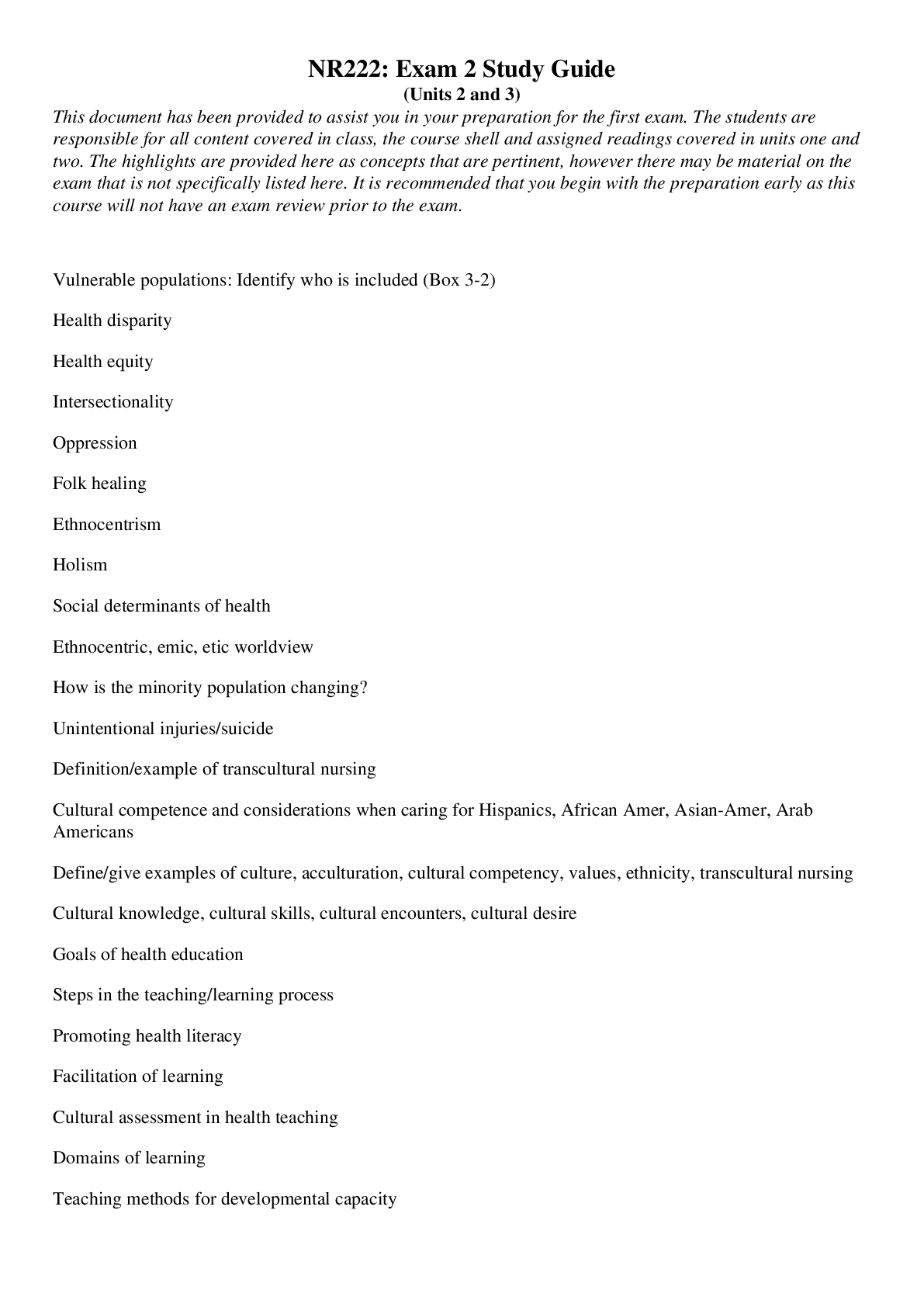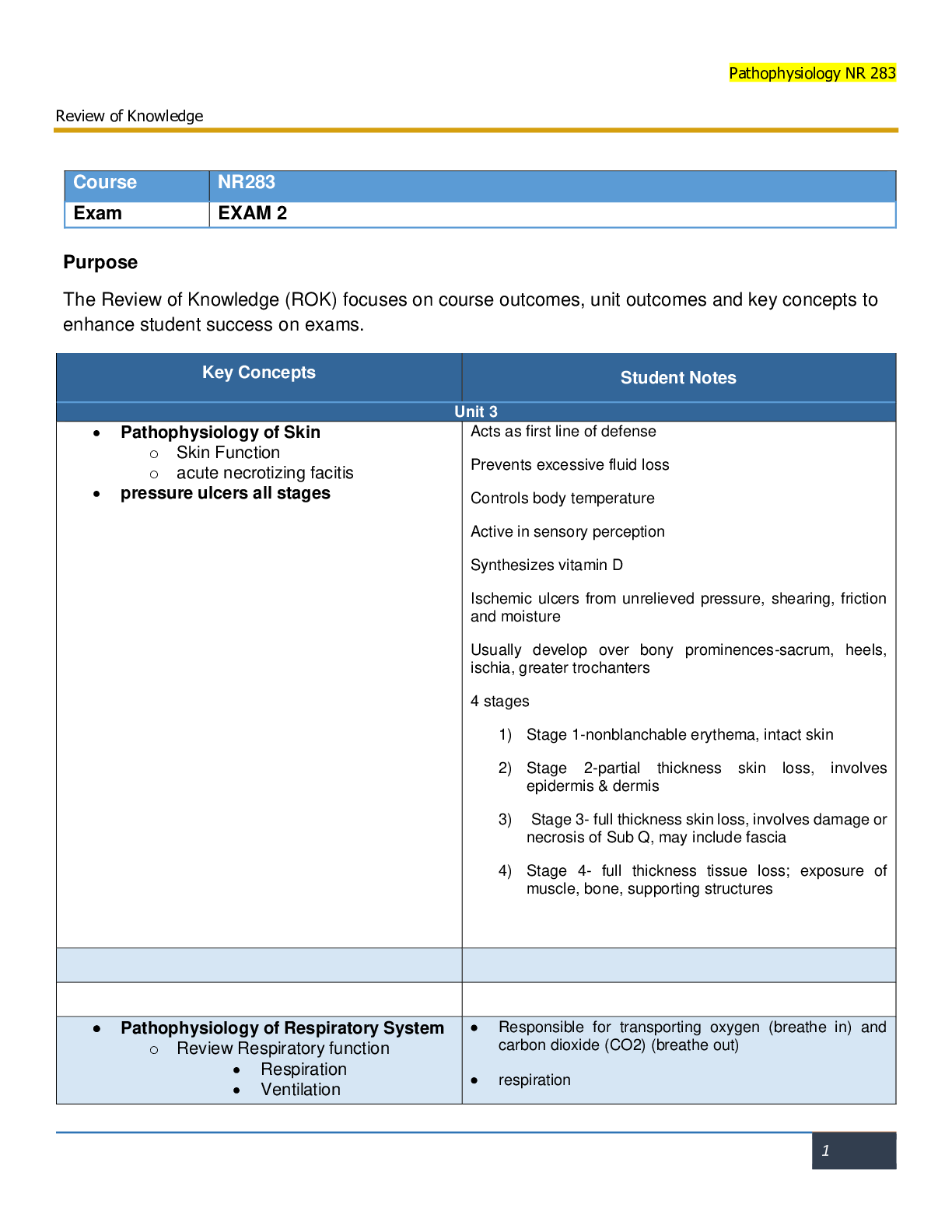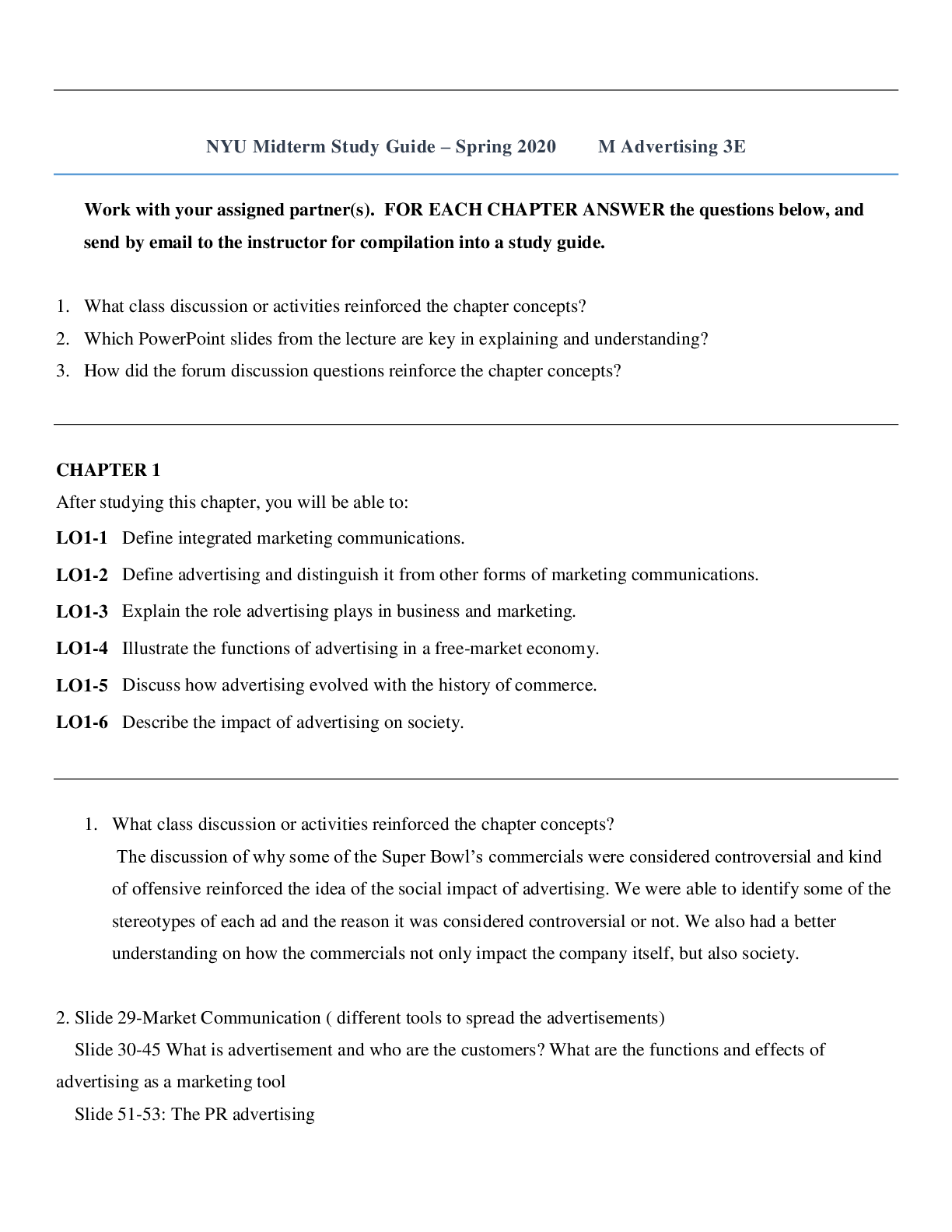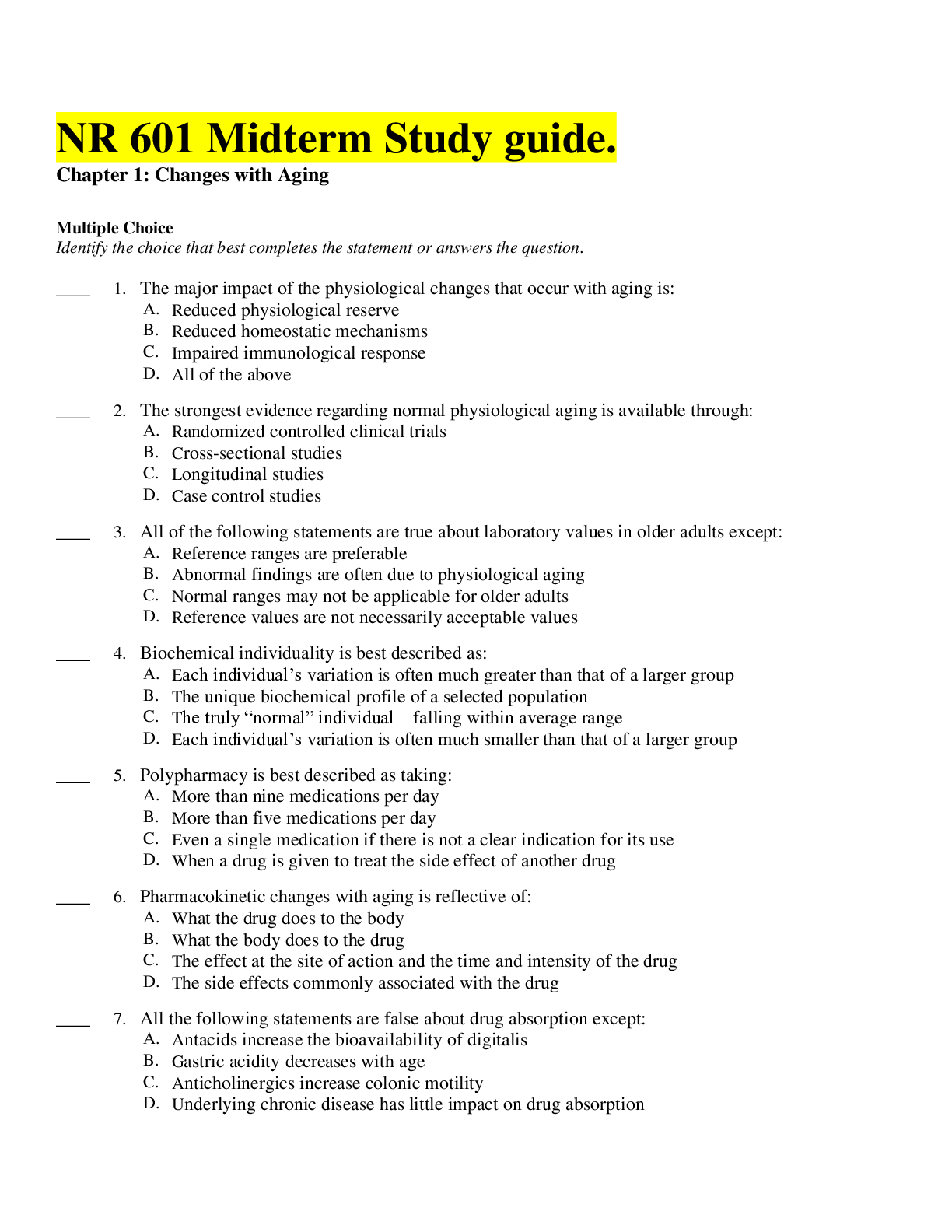*NURSING > STUDY GUIDE > NR 602 Midterm Study guide Latest - Chamberlain College of Nursing (All)
NR 602 Midterm Study guide Latest - Chamberlain College of Nursing
Document Content and Description Below
NR 602 Midterm Study guide Latest - Chamberlain College of Nursing Chalazion Chalazion is a chronic sterile inflammation of the eyelid resulting from a lipogranuloma of the meibomian glands that l... ine the posterior margins of the eyelids (see Fig. 29-7). It is deeper in the eyelid tissue than a hordeolum and may result from an internal hordeolum or retained lipid granular secretions. Clinical Findings Initially, mild erythema and slight swelling of the involved eyelid are seen. After a few days the inflammation resolves, and a slow growing, round, nonpigmented, painless (key finding) mass remains. It may persist for a long time and is a commonly acquired lid lesion seen in children (see Fig. 29-7). 727 Management • Acute lesions are treated with hot compresses. • Refer to an ophthalmologist for surgical incision or topical intralesional corticosteroid injections if the condition is unresolved or if the lesion causes cosmetic concerns. A chalazion can distort vision by causing astigmatism as a result of pressure on the orbit. Complications Recurrence is common. Fragile, vascular granulation tissue called pyogenic granuloma that enlarges and bleeds rapidly can occur if a chalazion breaks through the conjunctival surface. Blepharitis Blepharitis is an acute or chronic inflammation of the eyelash follicles or meibomian sebaceous glands of the eyelids (or both). It is usually bilateral. There may be a history of contact lens wear or physical contact with another symptomatic person. It is commonly caused by contaminated makeup or contact lens solution. Poor hygiene, tear deficiency, rosacea, and seborrheic dermatitis of the scalp and face are also possible etiologic factors. The ulcerative form of blepharitis is usually caused by S. aureus. Nonulcerative blepharitis is occasionally seen in children with psoriasis, seborrhea, eczema, allergies, lice infestation, or in children with trisomy 21. Clinical Findings • Swelling and erythema of the eyelid margins and palpebral conjunctiva 726 • Flaky, scaly debris over eyelid margins on awakening; presence of lice • Gritty, burning feeling in eyes • Mild bulbar conjunctival injection • Ulcerative form: Hard scales at the base of the lashes (if the crust is removed, ulceration is seen at the hair follicles, the lashes fall out, and an associated conjunctivitis is present) Differential Diagnosis Pediculosis of the eyelashes. Management Explain to the patient that this may be chronic or relapsing. Instructions for the patient include: • Scrub the eyelashes and eyelids with a cotton-tipped applicator containing a weak (50%) solution of no-tears shampoo to maintain proper hygiene and debride the scales. • Use warm compresses for 5 to 10 minutes at a time two to four times a day and wipe away lid debris. • At times antistaphylococcal antibiotic (e.g., erythromycin 0.5% ophthalmic ointment) is used until symptoms subside and for at least 1 week thereafter. Ointment is preferable to eye drops because of increased duration of contact with the ocular tissue. Azithromycin 1% ophthalmic solution for 4 weeks may also be used (Shtein, 2014). • Treat associated seborrhea, psoriasis, eczema, or allergies as indicated. • Remove contact lenses and wear eyeglasses for the duration of the treatment period. Sterilize or clean lenses before reinserting. • Purchase new eye makeup; minimize use of mascara and eyeliner. • Use artificial tears for patients with inadequate tear pools. Chronic staphylococcal blepharitis and meibomian keratoconjunctivitis respond to oral erythromycin. Doxycycline, tetracycline, or minocycline can be used chronically in children older than 8 years old. Acute Otitis Media AOM is an acute infection of the middle ear (Fig. 30-4). The AAP Clinical Practice Guideline requires the presence of the following three components to diagnose AOM (Lieberthal et al, 2013): • Recent, abrupt onset of signs and symptoms of middle ear inflammation and effusion (ear pain, irritability, otorrhea, and/or fever) • MEE as confirmed by bulging TM, limited or absent mobility by pneumatic otoscopy, air-fluid level behind TM, and/or otorrhea • Signs and symptoms of middle ear inflammation as confirmed by distinct erythema of the TM or onset of ear pain (holding, tugging, rubbing of the ear in a nonverbal manner) Characteristics of different types of AOM are defined in Table 30-4. AOM often follows eustachian tube dysfunction (ETD). Common causes of ETD include upper respiratory infections, allergies, and ETS. ETD leads to 746functional eustachian tube obstruction and inflammation that decreases the protective ciliary action in the eustachian tube. When the eustachian tube is obstructed, negative pressure develops as air is absorbed in the middle ear (see Fig. 30-4). The negative pressure pulls fluid from the mucosal lining and causes an accumulation of sterile fluid. Bacteria pulled in from the eustachian tube lead to the accumulation of purulent fluid. Young children have shorter, more horizontal and more flaccid eustachian tubes that are easily disrupted by viruses, which predisposes them to AOM. Respiratory syncytial virus and influenza are two of the viruses most responsible for the increase in the incidence of AOM seen from January to April. Other risk factors associated with AOM are listed in Boxes 30-1 and 30-2. S. pneumoniae, nontypeable Haemophilus influenzae, Moraxella catarrhalis, and S. pyogenes (group A streptococci) are the most common infecting organisms in AOM (Conover, 2013). S. pneumoniaecontinues to be the most common bacteria responsible for AOM. The strains of S. pneumoniae in the heptavalent pneumococcal conjugate vaccine (PCV7) have virtually disappeared from the middle ear fluid of children with AOM (Lieberthal et al, 2013). With the introduction of the 13-valent S. pneumoniae vaccine, the bacteriology of the middle ear is likely to continue to evolve. Bullous myringitis is almost always caused by S. pneumonia. Nontypeable H. influenza remains a common cause of AOM. It is the most common cause of bilateral otitis media, severe inflammation of the TM, and otitis-conjunctivitis syndrome. M. catarrhalis obtained from the nasopharynx has become increasingly more beta-lactamase positive, but the high rate of clinical resolution in children with AOM from M. catarrhalis makes amoxicillin a good choice for initial therapy (Lieberthal et al, 2013). M. catarrhalis rarely causes invasive disease. S. pyogenes is responsible for AOM in older children, is responsible for more TM ruptures, and is more likely to cause mastoiditis. Although a virus is usually the initial causative factor in AOM, strict diagnostic criteria, careful specimen handling, and sensitive microbiologic techniques have shown that the majority of AOM is caused by bacteria or bacteria and virus together (Lieberthal et al, 2013). Clinical Findings History Rapid onset of signs and symptoms: • Ear pain with possible ear pulling in the infant; may interfere with activity and/or sleep • Irritability in an infant or toddler • Otorrhea • Fever Other key factors or symptoms: • Prematurity • Craniofacial anomalies or congenital syndromes associated with craniofacial anomalies • Exposure to risk factors • Disrupted sleep or inability to sleep • Lethargy, dizziness, tinnitus, and unsteady gait • Diarrhea and vomiting • Sudden hearing loss • Stuffy nose, rhinorrhea, and sneezing • Rare facial palsy and ataxia Physical Examination • Presence of MEE, confirmed by pneumatic otoscopy, tympanometry, or acoustic reflectometry, as evidenced by: • Bulging TM (see Fig. 30-4) • Decreased translucency of TM • Absent or decreased mobility of the TM • Air-fluid level behind the TM • Otorrhea 747 • Signs and symptoms of middle ear inflammation indicated by either: • Erythema of the TM (Amber is usually seen in otitis media with effusion [OME]; white or yellow may be seen in either AOM or OME [Shaikh et al, 2010].) or • Distinct otalgia that interferes with normal activity or sleep • In addition, the following TM findings may be present: • Increased vascularity with obscured or absent landmarks (see Fig. 30-4). • Red, yellow, or purple TM (Redness alone should not be used to diagnose AOM, especially in a crying child.) • Thin-walled, sagging bullae filled with straw-colored fluid seen with bullous myringitis Diagnostic Studies Pneumatic otoscopy is the simplest and most efficient way to diagnose AOM. Tympanometry reflects effusion (type B pattern). Tympanocentesis to identify the infecting organism is helpful in the treatment of infants younger than 2 months old. In older infants and children, tympanocentesis is rarely done and is useful only if the patient is toxic or immunocompromised or in the presence of resistant infection or acute pain from bullous myringitis. If a tympanocentesis is warranted, refer the patient to an otolaryngologist for this procedure. Differential Diagnosis OME, mastoiditis, dental abscess, sinusitis, lymphadenitis, parotitis, peritonsillar abscess, trauma, ETD, impacted teeth, temporomandibular joint dysfunction, and immune deficiency are differential diagnoses. Any infant 2 months old or younger with AOM should be evaluated for fever without focus and not just treated for an ear infection. Management Many changes have been made in the treatment of AOM because of the increasing rate of antibiotic-resistant bacteria related to the injudicious use of antibiotics. Ample evidence has been presented that symptom management may be all that is required in children with MEE without other symptoms of AOM (Lieberthal et al, 2013). Treatment guidelines are decided based on the child's age, illness severity, and the certainty of diagnosis. Table 30-5 shows the recommendation for the diagnosis and subsequent treatment of AOM. 1. Pain management is the first principle of treatment. • Weight-appropriate doses of ibuprofen or acetaminophen should be encouraged to decrease discomfort and fever. • Topical analgesics, such as benzocaine or antipyrine/benzocaine otic preparations, can be added to systemic pain management if the TM is known to be intact. Topical analgesics should not be used alone. • Distraction, oil application, or external use of heat or cold may be of some use. 2. Antibiotics are also effective. (Table 30-6 lists dosage recommendations.) • Amoxicillin remains the first-line antibiotic for AOM if there has not been a previous treated AOM in the previous 30 days, there is no conjunctivitis, and no penicillin allergy (Lieberthal et al, 2013). Beta-lactam coverage (amoxicillin/clavulanate, third-generation cephalosporin) is recommended when the child has been treated with amoxicillin in the previous 30 days, there is an allergy to penicillin, and the child has concurrent conjunctivitis or has recurrent otitis that has not responded to amoxicillin. If there is a documented hypersensitivity reaction to amoxicillin, the following antibiotics are acceptable, follow the non-type 1 hypersensitivity and type 1 hypersensitivity recommendations in Table 30-6: • Ceftriaxone may be effective for the vomiting child, the child unable to tolerate oral medications, or the child who has failed amoxicillin/clavulanate. 748 • Clindamycin may be considered for ceftriaxone failure but should only be used if susceptibilities are known. • Prophylactic antibiotics for chronic or recurrent AOM are not recommended. 3. Observation or “watchful waiting” for 48 to 72 hours (see Table 30-5) allows the patient to improve without antibiotic treatment. Pain relief should be provided, and a means of follow-up must be in place. Options for follow-up include: • Parent-initiated visit or phone call for worsening or no improvement • Scheduled follow-up appointment • Routine follow-up phone call • Given a prescription to be started if the child's symptoms do not improve or if they worsen in 48 to 72 hours (Table 30-7) • Communication with the parent, reevaluation, and the ability to obtain medication must be in place. 4. Recommendations for follow-up include: • After 48 to 72 hours if a child has not showed improvement in ear symptomatology, the child should be seen to confirm or exclude the presence of AOM. If the initial management option was an antibacterial agent, the agent should be changed. Prevention and Education The following interventions, shown to be helpful in preventing AOM, should be encouraged: • Exclusive breastfeeding until at least 6 months of age seems to be protective against AOM • Avoid bottle propping, feeding infants lying down, and passive smoke exposure • Avoid the use of pacifiers: Although the relationship cannot be fully explained, multiple studies have shown that pacifier use increases the incidence of AOM (Lieberthal et al, 2013). • Pneumococcal vaccine; specifically PCV13, which contains subtype 19A • Annual influenza vaccine may help prevent otitis media 750 • Xylitol liquid or chewing gum as tolerated • Choose licensed day care facilities with fewer children • Educate regarding the problem of drug-resistant bacteria and the need to avoid the use of antibiotics unless absolutely necessary; if antibiotics are used, the child needs to complete the entire course of the prescription and follow up if symptoms do not resolve Conjunctivitis An estimated 6 million cases of bacterial conjunctivitis occur in the United States annually, at an estimated cost of $377 million to $857 million (Azari and Barney, 2013). Conjunctivitis is an inflammation of the palpebral and occasionally the bulbar conjunctiva (Fig. 29-5). It is the most frequently seen ocular disorder in pediatric practice. In pediatric patients, bacteria are the most common cause of infection (50% to 75%) most commonly from December to April. Pathogens include H. influenzae, Streptococcus pneumoniae, and Moraxella species with both gram-negative and gram-positive organisms implicated (Azari and Barney, 2013). Conjunctivitis also occurs as a viral or fungal infection or as a response to allergens or chemical irritants. Bacterial conjunctivitis is often unilateral, whereas viral conjunctivitis is most often bilateral. Unilateral disease can also suggest a toxic, chemical, mechanical, or lacrimal cause. Blockage of the tear drainage system (e.g., from meibomianitis or blepharitis), injury, foreign body, abrasion or ulcers, keratitis, iritis, herpes simplex virus (HSV), and infantile glaucoma are other known causes. Patient age is a major indicator of etiology (Table 29-6). Types of Conjunctivitis - - - - - - - - - - - - - - - Studies indicate that 40% of children will experience a headache by 7 years old and 75% by 15 years old (Rubin et al, 2010). Prevalence rates for migraine headaches are reported to be: age 3 (3% to 8%), age 5 (19.5%), age 7 (37% to 51%), and 7 to 15 years old (57% to 82%). Before 10 years old, the incidence is higher in males than females. During teenage years, females have a higher headache incidence. The mean age at onset of migraine is 7.2 years old for males and 10.9 years old for females (Lewis et al, 2004). The provider must discern between symptoms that suggest that a headache is primary (e.g., tension-type, cluster, migraine type) or due to a secondary cause (e.g., tumor, hydrocephaly, infection, intoxication [lead, carbon monoxide], idiopathic intracranial hypertension, increased intracranial pressure). Key historical questions and a thorough workup are mandatory in order to exclude secondary headache etiology. In the absence of findings suggestive of a secondary headache, a more certain diagnosis of a primary headache disorder can be made. The International Headache Society (IHS) provides succinct clinical criteria (available at www.ihs-classification.org/en/) to help the provider evaluate, delineate between, and classify primary headaches (e.g., including migraines with or without aura and migraine subtypes) and secondary headaches. Clinical Findings History. Headache diaries may be used to gather history and track symptoms over time. Some useful ones are available for downloading at www.achenet.org/resources/headache_diaries/. Important questions to ask the child and parent(s) include: • Duration: Recent severe onset is worrisome. • Frequency and triggers: Children with recurrent, low-intensity headaches, with no neurologic changes, and who recover completely between episodes are unlikely to have serious intracranial etiology. Triggers can include ovulation or menstruation, exercise, food or odors, and stress. Other triggers can include chocolate, processed meats, aged cheeses, nuts, altered amounts of caffeine intake, dairy products, shellfish, and some dried fruits. Consistent findings such as perimenstrual exacerbation, food triggers, and a stable pattern to the headache with intervals of wellness over a long time period are reassuring symptoms that suggest a primary headache. 686In most cases, a specific trigger or etiology is not ever identified. • Location: Occipital or consistently localized headaches can indicate underlying pathology. Facial pain might be sinusitis. Ocular motor imbalance can produce a dull periorbital discomfort, whereas temporomandibular joint pain tends to localize around the periauricular or temporal areas. • Quality and severity of pain: Sharp, throbbing, or pounding pain is vascular (migraine). Dull and constant pain may be tension or organic. Severity can be assessed by asking about limitations to activities and missed school days, although there are other factors that contribute to missed school and limited activities. How many “different kinds of headaches” are experienced? • Age of onset: Progression of the headaches over time and longest period of time without symptoms. • Home management and medication dosages, including dosage and self-management activities. • Associated symptoms can include nausea, vomiting, visual changes, dizziness, paresthesia, neck/shoulder pain, back pain, otalgia, abdominal pain, hypersomnia, food cravings, confusion, ataxia, pallor, photophobia, and phonophobia. Changes in gait, personality, vision, mentation, or behavior that do not occur at the same time as the headache are worrisome and merit further evaluation with referral. There are some precursor symptoms and conditions that can indicate a predisposition to migraines. These include cyclic vomiting (see Chapter 33), abdominal migraine (see Chapter 33), and BPV. Alone, they do not warrant extensive or expensive workups unless the diagnosis is unclear. These conditions may evolve into migraine without aura in later childhood (Hershey, 2011; Lewis et al, 2008a). • Head trauma: If associated with headache, a subdural hematoma or postconcussive syndrome must be considered. • Psychologic symptoms: Evaluate for the presence of depression, school stressors, or concerns about family functioning. Additional things to consider include bullying or peer issues at school, “over programming” and family expectations, and meal, hydration, and sleep status. • Family history: Some children with headache, especially migraine, have a family history of headaches. Distinguishing Features of Headache Types • Migraine and migraine with aura: These can be differentiated by the presence or absence of aura symptoms (Table 28-6). Characteristics of migraines include nausea, abdominal pain, vomiting, unilateral pain, pulsating pain, relief with sleep, an aura, visual changes such as dark or blind spots, and a history of a family member (usually on the maternal side) with migraine without aura. Dizziness and motion sickness may be described. Infants and toddlers may present with irritability, sleepiness, and pallor. In preadolescents, common migraine symptoms are more likely. Nausea and vomiting might not occur, and the pain can be more frontal. Lethargy and sleep can follow. Visual changes are rare, and the pain quality is variable. Times between headaches are pain free. • Abdominal migraine: This is rare and is a somewhat controversial diagnosis; symptoms include midline pain, nausea, and vomiting with minimal or no headache. 687Such symptoms can also be suggestive of complex partial seizures. • Muscle contraction or tension headaches: The pain is dull and bifrontal or occipital, with nausea and vomiting occurring only rarely; there is no prodrome. Tension headaches can last for days or weeks but generally do not interfere with activities. In children, it can be difficult to differentiate migraine and tension-type headaches. Psychosocial stress seems to be a major factor in tension and chronic daily headaches in both children and adolescents. • Secondary headaches (or those headaches that have a pathologic process): Key historical markers are sudden onset of hyperacute or increasing pain severity or accompanying neurologic signs. These require prompt referral. Box 28-5 presents red flag warnings of a pathologic process indicating immediate referral. Presenting symptoms of these headaches include the following (Lewis et al, 2008b; Sprague-McRae et al, 2009): • Headache pain that is worse in the morning on awakening and standing up, and then fades; increases in frequency and severity over a period of only a few weeks; persistent and unilateral • Pain that wakens the child from sleep • Vomiting but not nausea; vomiting may relieve the headache • Visual disturbances, diplopia, edema of the optic disc (papilledema) • Increased pain with straining, sneezing, coughing, defecation, or changes in position • Occipital region and neck pain • Educational, mental, personality, or behavioral alterations; irritability • Seizures • Unsteadiness or dramatic changes in balance • Fever • Family history of neurologic disorders (e.g., brain tumors, neurofibromatosis, vascular malformations) • Child has a history of a ventriculoperitoneal shunt, meningitis, hydrocephaly, or tumor Physical Examination. A complete physical and neurologic examination is in order: • Blood pressure, supine and standing with 2-minute interval between them • Height and weight • Head circumference (all children) • Eyes: Palpate for tenderness; check discs for papilledema, movements • Ears: Patency of canals, normal tympanic membranes • Neck: Palpate muscles; check range of motion for nuchal rigidity • Sinuses (frontal and maxillary) • Teeth (percuss, inspect) • Temporomandibular joints (mouth and jaw): Palpate and check range of motion • Thyroid gland • Bones and muscles of skull: Palpate for tenderness; listen for cranial bruits; check range of motion of cervical spine • Extremities: Tandem gait • Nerves: Palpate supraorbital, trochlear, occipital nerves; assess CN IX to CN XII • Reflexes: Pronator drift test (Romberg) • Vision screen Diagnostic Studies. Imaging studies are rarely indicated unless the history suggests intracranial pressure (see Box 28-5); there is a sudden onset, increased severity, or change in headache pattern; the neurologic examination is abnormal; or when a complaint of “dizziness” fits the criteria listed in Table 28-7. CTs are generally out of favor due to radiation. MRI is the first-line treatment unless extremely urgent and it cannot be obtained immediately. If abnormal, an MRI should be done. An EEG should be obtained if the history and physical examination suggest a seizure process. 688If there is a history of external trauma, such as from a motor vehicle accident, cervical and spinal x-rays should be ordered. Differential Diagnosis The differential diagnosis consists of sinusitis, trigeminal neuralgia, pseudotumor cerebri, sleep disorder, hyperthyroidism, hypertension, cyclic vomiting, abdominal migraine, BPV, and temporomandibular joint dysfunction. Brain tumors, abscesses, hematomas, and arteriovenous malformations in children are generally associated with ataxia, papilledema, intellectual changes, or behavioral changes. These processes are termed space occupying lesions because they crowd out other intracranial structures, precipitating edema and interfering with the normal actions of CSF and vessels. Infants may initially accommodate well to the increase in intracranial pressure because of the ability of their cranial sutures to expand. Visual acuity is rarely a cause of headaches. Determining the correct headache classification or entity is also part of the differential diagnosis. These and other causes of headaches in children are outlined in (Table 28-8). Management For nonorganic headaches, there may be no known etiology (e.g., no tumor, aneurysm, or metabolic or structural cause). The child and parents should be taught pain and stress management techniques; nonsteroidal anti-inflammatory drugs are the first-line pharmaceutical for acute treatment. There can be significant loss of school attendance as a result of headaches, but attendance should be mandatory. A quiet 689rest period may be allowed at school if needed, and school nurses can be helpful in developing a plan for this. If the child remains home, activities should be restricted to bed and all homework completed. The child should be returned to school if the pain improves during the school day. Minimize attention to the headache. Relaxation exercises or biofeedback training can be helpful. Trigger factors should be avoided, if possible. The goals of treating acute-onset migraines include: • Abortive therapy • Reducing frequency, severity, and length of treatment • Reducing impairment • Improving overall quality of life • Avoiding escalation of medications • Optimizing self-care abilities of the patient and family • Using beneficial and cost-effective treatment • Minimizing medication side effects Many of the newer medications for migraines (e.g., triptans) have not been adequately tested for safety and efficacy in children and adolescents, with the exception of sumatriptan and zolmitriptan (refer to Table 28-9 for treatment options). Lewis (2009) recommends treating throughout the school year and then gradually curtailing daily agents during the summer months. An alternative for younger children is to use shorter courses of preventive medications (6 to 8 weeks) followed by gradual weaning. All individuals with migraines benefit from regular sleep, exercise, moderate caffeine intake, and adequate hydration. Medications should be taken as soon as possible after the onset of the headache; should be taken in the prescribed dosage; should be available at home, school, or work; and the overuse of analgesics is to be avoided (more than three doses per week). Prophylactic therapy is considered when migraines cause a child to miss school regularly and when the child suffers severe migraine headaches two to four times a month or tension or migraine three to four times per week with a clear sense of functional disability. The aim of prophylactic treatment is to reduce headache severity, frequency, or both (El-Chammas et al, 2013). Medication classifications to consider include beta-blockers, antidepressants, anticonvulsants that treat headaches also, or calcium channel blockers. The use of magnesium oxide, CoQ10, and riboflavin as dietary supplements is gaining popularity in practice due to tolerance, cost, and ease of use. However, the evidence in favor of these modalities is limited, and further research is warranted (Orr and Venkateswaran, 2014). Refer all patients with organic (structural) headaches. Parents seek medical attention for pain relief for their child, in addition to reassurance that there are no intracranial processes occurring (brain tumors). Each child with headaches requires an individually tailored strategy that may include pharmacologic and nonpharmacologic modalities. Complications School absence and depression are known complications. [Show More]
Last updated: 2 years ago
Preview 1 out of 121 pages
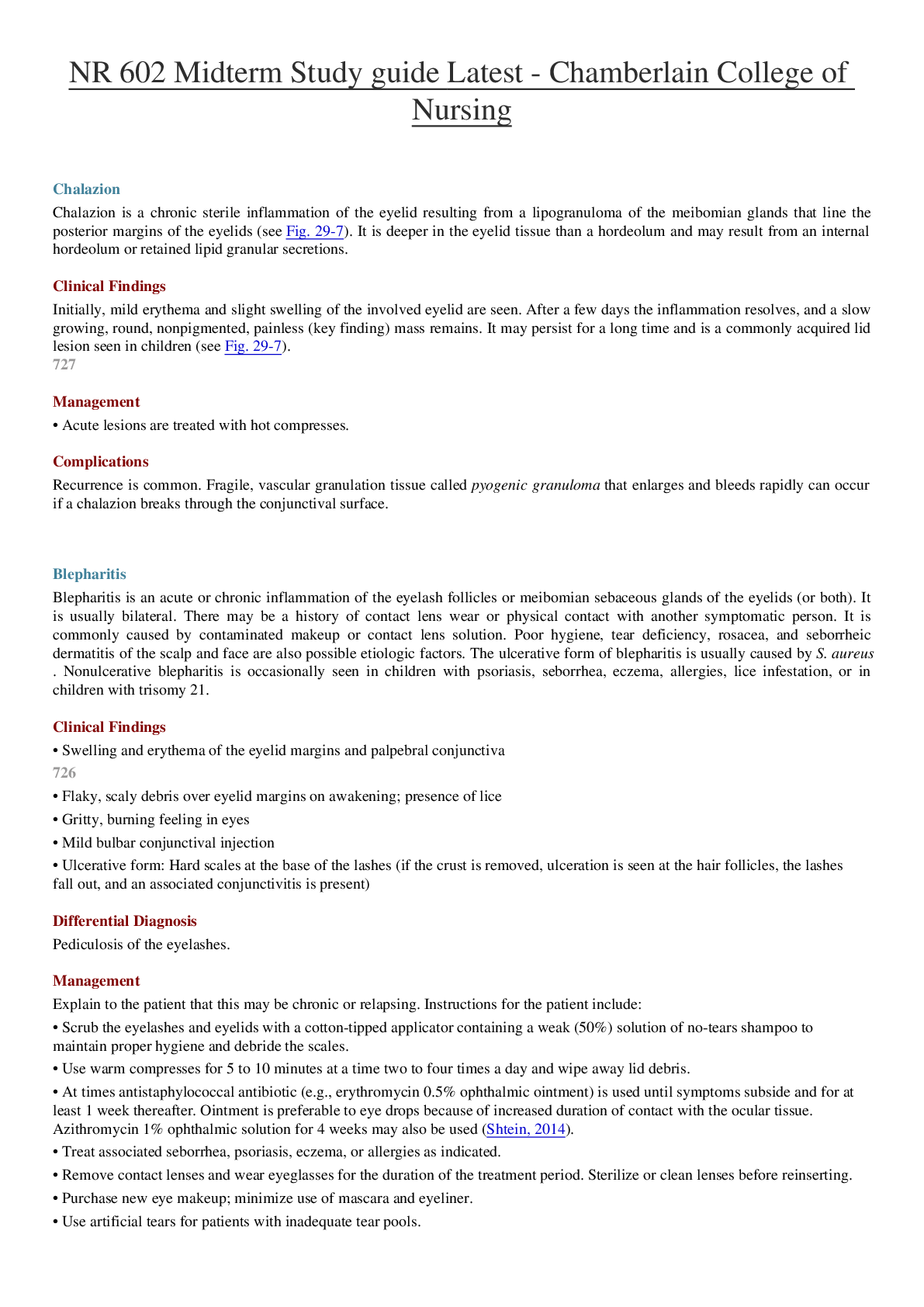
Buy this document to get the full access instantly
Instant Download Access after purchase
Buy NowInstant download
We Accept:

Reviews( 0 )
$18.00
Can't find what you want? Try our AI powered Search
Document information
Connected school, study & course
About the document
Uploaded On
May 30, 2020
Number of pages
121
Written in
Additional information
This document has been written for:
Uploaded
May 30, 2020
Downloads
0
Views
121







